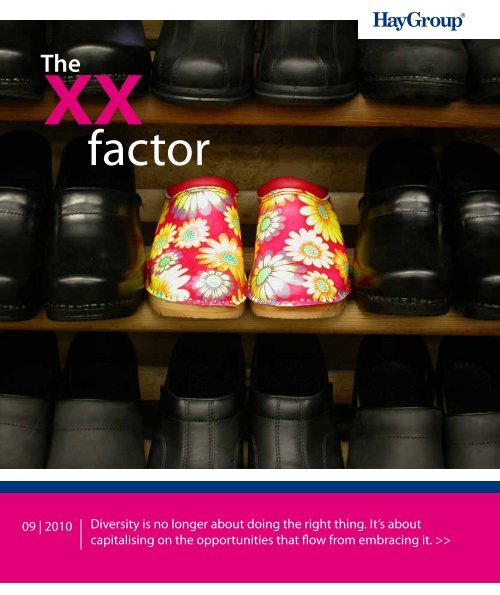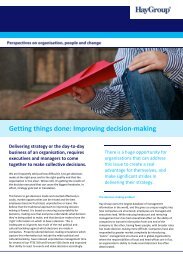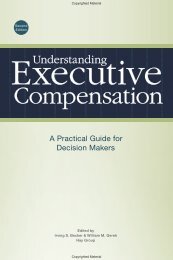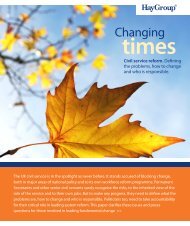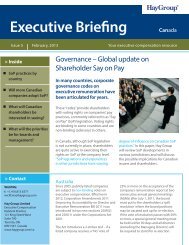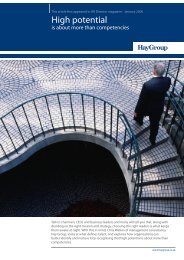The XX factor - Hay Group
The XX factor - Hay Group
The XX factor - Hay Group
You also want an ePaper? Increase the reach of your titles
YUMPU automatically turns print PDFs into web optimized ePapers that Google loves.
<strong>The</strong><br />
xx<br />
<strong>factor</strong><br />
09 | 2010 Diversity is no longer about doing the right thing. It’s about<br />
capitalising on the opportunities that flow from embracing it. >>
Julia Gillard smashed a political glass ceiling when she became<br />
Australia’s first female Prime Minister in June 2010. Since<br />
then she’s had to endure a baptism of fire during Australia’s<br />
closest ever Federal Election to finally become the first elected<br />
woman as Prime Minister in September 2010. Ms Gillard only<br />
managed to cling onto power with the assistance of a number<br />
of key independent MPs. She then pledged a different form of<br />
leadership post election - to be more consultative and more<br />
inclusive than her predecessors, a leadership quality often more<br />
associated with female leaders in the business sector.
Contents<br />
Gender diversity<br />
2<br />
State of play for women in Australia and New Zealand<br />
4<br />
<strong>The</strong> Solution - <strong>The</strong> 7 lever model<br />
5<br />
Conclusion<br />
16
2<br />
<strong>The</strong> <strong>XX</strong> <strong>factor</strong><br />
Gender diversity<br />
<strong>Hay</strong> <strong>Group</strong> research proves<br />
that fostering women<br />
into leadership positions<br />
actually has a quantifiable<br />
impact on improving<br />
business performance.<br />
<strong>The</strong> untapped driver for business<br />
success<br />
We talk about the X <strong>factor</strong> that drives<br />
business – striving to get that slight edge to<br />
improve performance and stay ahead of the<br />
competition. But there’s actually an <strong>XX</strong> <strong>factor</strong><br />
– <strong>Hay</strong> <strong>Group</strong> research proves that fostering<br />
women into leadership positions actually has<br />
a quantifiable impact on improving business<br />
performance. <strong>The</strong> 2009 Best Companies for<br />
Leadership report commissioned by <strong>Hay</strong> <strong>Group</strong><br />
and Bloomberg/BusinessWeek shows that two<br />
thirds of the companies rated in the top 20<br />
have a high proportion of women in senior<br />
leadership roles. <strong>The</strong>se same top 20 companies<br />
in the global <strong>Hay</strong> <strong>Group</strong> survey produced eight<br />
times better shareholder returns than their<br />
peers over a five year period. What does that<br />
mean? Ultimately embracing diversity in the<br />
workplace – especially encouraging women to<br />
succeed into senior roles - flows through to the<br />
bottom line.<br />
In addition, a report in 2009 by Goldman<br />
Sachs JB Were indicated that closing the<br />
gender gap in Australia could add 11 per cent<br />
to Australia’s GDP in improved productivity<br />
performance – or the equivalent of about<br />
$120 billion. That’s even more than the US,<br />
where the same report suggested a 9 per cent<br />
improvement in GDP by redressing gender<br />
imbalance. In Japan, that estimate blew out to<br />
a 16 per cent enhancement.<br />
<strong>The</strong> opportunity<br />
What CEO would say ‘no’ to significantly<br />
improving their business’s performance?<br />
What Prime Minister or elected government<br />
would say ‘no’ to increasing the GDP of their<br />
country by 11 per cent?<br />
This is the opportunity facing organisations in<br />
Australia today, to embrace diversity as a source<br />
of competitive and social advantage. In this<br />
article, we make the business case for businesses<br />
to adopt gender diversity as a priority. We<br />
outline a solution which requires executive<br />
commitment and a holistic approach to<br />
achieve these benefits and create an energising<br />
environment for all employees.<br />
Embracing gender diversity - Push or<br />
Pull?<br />
Good intentions are no longer good enough<br />
– and for those too slow to move there is a big<br />
stick on the way. In Australia, since July 2010,<br />
the ASX requires companies to set out in their<br />
annual report how well they are meeting their<br />
board set gender objectives. <strong>The</strong>y are required<br />
to list the number of women in the whole<br />
organisation, in senior management and on<br />
the board. This process will begin to shine a<br />
light on practices within organisations when<br />
it comes to gender balance – prompting many<br />
companies into action.<br />
©2010 <strong>Hay</strong> <strong>Group</strong>. All rights reserved
“<br />
If the representation of women on boards and in senior management hasn’t<br />
improved, the question is what else can or should the Government or the<br />
ASX do . . .? the next logical thing the ASX could do is use the listing rules (option),<br />
and say ‘it’s now required for every company to have a diversity policy’.<br />
Eric Mayne - Chief Executive, ASX Corporate Governance Council<br />
“<br />
Since July 2010, the ASX<br />
requires companies to list<br />
in their annual reports, the<br />
number of women in the<br />
whole organisation, senior<br />
management and on the<br />
board.<br />
Governments are also moving swiftly. In early<br />
2010 the French National Assembly approved<br />
a bill requiring women fill 50 per cent of<br />
board positions by 2015 – following on from<br />
similar provisions in Norway. <strong>The</strong>re is building<br />
momentum in Australia for the government to<br />
set mandatory targets (especially for companies<br />
employing more than 100 people) and the<br />
Equal Opportunity in the Workplace Agency<br />
(EOWA) are already taking a review – with the<br />
Office of Women due to report in late 2010.<br />
It has been suggested that targets will apply<br />
to both government boards as well as publicly<br />
listed companies.<br />
In New Zealand, Prime Minister John Key<br />
launched the ‘Women on Boards’ initiative<br />
in May 2009 – highlighting international<br />
evidence that companies with more women on<br />
their boards are stronger performers than those<br />
with no or few women in the boardroom.<br />
<strong>Hay</strong> <strong>Group</strong> believes that organisations do not<br />
need to be pushed along by a big stick to do<br />
the right thing when it comes to fostering<br />
diversity. Instead, as outlined in the following<br />
pages there is a huge incentive for organisations<br />
to embrace diversity. Recognising the benefits<br />
of getting it right will be the motivation that<br />
the best leaders will need to get on board.
4<br />
<strong>The</strong> <strong>XX</strong> <strong>factor</strong><br />
State of play for<br />
women<br />
in Australia & New Zealand<br />
While both Australia and New Zealand might pride themselves on being very progressive<br />
societies, the reality is they are among the worst performing in the OECD for promoting women<br />
in leadership positions. <strong>The</strong> surprising news is that there are predictions that this will only get<br />
worse.<br />
• Women hold only 2 per cent of CEO and 10.7 per cent of senior management positions in ASX<br />
<strong>The</strong> 200 poor companies track record:<br />
• <strong>The</strong> majority of women who make it into executive management roles in ASX 200 companies<br />
are still clustered in roles that support the main business functions – human resources, legal,<br />
public relations etc<br />
• Women chair only 2 per cent of ASX 200 companies and hold only 8.3 per cent of board director<br />
roles<br />
• While 54.5 per cent of ASX 200 companies have at least one woman in an executive<br />
management position – that is poor by international standards. In the US 85.2 per cent of<br />
companies have at least one woman in a senior executive position and the rates are in excess of<br />
60 per cent for both the UK and Canada.<br />
• Women are only paid 83 per cent of the pay of men for work of comparable value in Australia<br />
• For every $1 earned by men in New Zealand today, women earn just 88 cents<br />
Sources: KPMG - office of Women , Department of Families, Housing and Communities and EOWA<br />
<strong>The</strong> reality is that in 2010 women are still chronically under-represented on boards and noticeably<br />
absent from senior management jobs in both Australia and New Zealand, despite their similar<br />
beginnings at university.<br />
How will the future be different?<br />
<strong>The</strong> overall and sad reality of the workforce in both Australia and New Zealand is the majority of<br />
women are employed in lower paid, lower level, lower valued roles.<br />
<strong>The</strong> response so far to a deteriorating situation has been a combination of government or industry<br />
reviews, reports and calls for a regulatory and legislative approach. Now is the time for companies<br />
to take a voluntary approach to addressing the gender issue – and for the right business reasons.<br />
©2010 <strong>Hay</strong> <strong>Group</strong>. All rights reserved
<strong>The</strong> Solution<br />
Many attempts have been made to address gender diversity. However, these<br />
failed to gain momentum, as they’ve tended to offer up isolated or sporadic solutions<br />
(e.g. simply setting up diversity committees). This issue requires an<br />
integrated and systematic approach.<br />
<strong>The</strong> 7 lever<br />
model recognises<br />
that the key to<br />
improving gender<br />
diversity does not<br />
reside within one<br />
functional area or<br />
process.<br />
<strong>The</strong> 7 lever model - the ‘whole’ system perspective<br />
Over the course of the past decades, <strong>Hay</strong> <strong>Group</strong> have been hearing of many different programs<br />
focused on developing women to succeed in a male dominated world and these programs have<br />
been mildly successful. We study and applaud those women who manage to reject the odds and<br />
rise to the top of their organisations. However, these women represent the exception, not the rule.<br />
At <strong>Hay</strong> <strong>Group</strong>, we believe that change needs to be led from the top and supported in a holistic<br />
manner throughout the organisation. Without systematic change to the way we think about our<br />
work, our customers and our employees, businesses will not maximise their potential. Nor will<br />
their employees, men or women, deliver their best performance.<br />
What <strong>Hay</strong> <strong>Group</strong>’s 7 lever model recognises is that the key to improving gender diversity<br />
does not reside within one functional area or process, for example recruitment and selection<br />
or reward. It requires a holistic approach that incorporates how the organisation structures its<br />
operations, provides and supports the values and culture that support diversity and connects with<br />
performance management and succession planning. Against this backdrop, of course, all of these<br />
measures need to support and reinforce the organisation’s business objectives.<br />
<strong>The</strong> 7 lever model comprehensively addresses the systemic barriers to diversity and promotes a<br />
healthier approach to growing and developing an environment for improving diversity:<br />
<strong>The</strong> 7 lever model<br />
HR Policies &<br />
Procedures<br />
Values<br />
& Culture<br />
Management<br />
Processes<br />
& Systems<br />
Strategy<br />
Critical<br />
Success<br />
Factors<br />
Leadership<br />
Results<br />
Organisation,<br />
Team & Job<br />
Design<br />
Individual<br />
& Team<br />
Capabilities<br />
Reward &<br />
Recognition<br />
In the next sections we will describe the attributes of each element and provide some illustrations<br />
of how these work in some Australian/New Zealand organisations.
6<br />
<strong>The</strong> <strong>XX</strong> <strong>factor</strong><br />
Strategy and Critical Success Factors<br />
Any substantial organisational change must be embedded in the organisation’s long term strategy<br />
and critical success <strong>factor</strong>s. Organisations that are successful in meeting their gender and diversity<br />
objectives see this issue as a key component of their business strategy and one of the critical success<br />
<strong>factor</strong>s they use to measure the broader success of their business. A diversity/gender program<br />
which is not aligned to the organisation’s business goals will not be sustainable over the longer<br />
term. That means CEO commitment and integration to the business strategy is key. <strong>Hay</strong> <strong>Group</strong><br />
works with organisations to help them to decode their strategy and link this to the levers that will<br />
ensure the successful delivery of this strategy and create an energising environment for success.<br />
While most organisations recognise the business benefits of embracing diversity, most<br />
organisations struggle with taking this intent and making it happen. We see diversity ‘strategies’<br />
that fail to gain momentum. Having an understanding of organisations, people and jobs we<br />
believe many organisations can take their diversity plans and translate them into actions and<br />
produce real sustainable outcomes.<br />
Questions to consider:<br />
• Is the new and emerging culture consistent with the desired strategy and vision?<br />
• Does your organisation have well-articulated values and culture which define how people<br />
behave?<br />
• Does the current organisational culture embrace gender and diversity?<br />
©2010 <strong>Hay</strong> <strong>Group</strong>. All rights reserved
1. Leadership<br />
Women in leadership<br />
make a difference<br />
<strong>Hay</strong> <strong>Group</strong> research in<br />
an earlier longitudinal<br />
project examined female<br />
motivational patterns and<br />
their use of leadership<br />
styles. We found that<br />
women apply 75 per cent<br />
of leadership behaviours<br />
identified as most<br />
effective in managing<br />
business challenges more<br />
frequently than men.<br />
Source: Women Matter, 2007;<br />
Women Matter 2, 2008<br />
Adopting a diversity program, has to begin at<br />
the top of the organisation. <strong>The</strong> CEO needs<br />
to make a visible and strong commitment<br />
to diversity and hold his/her direct reports<br />
accountable for adopting and reinforcing<br />
diversity in their functional areas. Top teams<br />
lead the way, as they are role modelling the<br />
behaviours that set the tone for the rest of the<br />
organisation. What leaders choose to reinforce<br />
and choose to ignore is also a critical driver<br />
in the organisation. In addition, they lead the<br />
organisational rituals that reinforce this culture.<br />
<strong>The</strong>refore, it makes sense for executive teams<br />
to invest time understanding and proactively<br />
managing the role models, rituals, rules and<br />
rewards that shape their culture. Managing<br />
Questions to consider:<br />
• Is the vision of leadership for your company male dominated?<br />
these forces can help turn a diversity strategy<br />
into reality.<br />
Diversity requires skilful management of a<br />
paradox: on the one hand, it is about leveraging<br />
differences based on the respective backgrounds<br />
for the benefit of an organisation. On the other<br />
hand it is the need to be uncompromising<br />
on certain corporate values, regardless of<br />
individual backgrounds. Diversity needs to<br />
be carefully and proactively managed and<br />
consistently linked to the business benefits to<br />
be achieved.<br />
• Do people understand the leadership’s vision for change and why the focus on diversity is<br />
necessary?<br />
• Do the leaders know what is expected of them and what role they play in implementing the<br />
changes required to meet the organsation’s gender goals?<br />
• Are leaders aware of how to communicate to support and coach women?<br />
<strong>Hay</strong> <strong>Group</strong> works with top teams to facilitate their journey in creating an<br />
energised top team committed to their diversity goals. Based on our research,<br />
conducted in conjunction with Richard Hackman at MIT and Ruth Wageman at<br />
Harvard into what makes great top teams work, we help top teams to visualise<br />
the future, set goals and role model the behaviours that will reinforce their<br />
diversity message. We work with them to increase their awareness of the psychological<br />
drivers of prejudice and develop strategies to overcome structural<br />
biases that block the progress of diversity.
8<br />
<strong>The</strong> <strong>XX</strong> <strong>factor</strong><br />
Unilever, (a multinational<br />
consumer goods<br />
company) went<br />
through a systematic<br />
process and now over<br />
30 per cent of their<br />
managers worldwide<br />
are women with over 30<br />
nationalities represented<br />
in their top 200 positions<br />
2. Values and culture<br />
Culture is all-important in setting the tone<br />
for people’s behaviour in organisations. It is<br />
‘the way things are done’ in an organisation,<br />
encapsulating widely-held (but often<br />
subconscious) assumptions and beliefs about<br />
what the organisation stands for, how people<br />
should behave, and how to really make things<br />
happen.<br />
Culture always begins at the top. Many<br />
organisations let their culture ‘happen’ rather<br />
than seriously understand and address the<br />
dysfunctional attributes of their culture which<br />
may have a demoralising effect on both males<br />
and females in their organisation. However,<br />
opportunities exist for organisations that<br />
choose to act quickly and decisively, to build an<br />
organisational culture which will enable them<br />
to thrive in the new world of diversity.<br />
<strong>The</strong> role of culture in strategy is clear: a<br />
particular way of doing things may be<br />
aligned with the strategy and help to embed<br />
it in practice or it may be in conflict with it,<br />
acting as a drag on change. If strategy only<br />
lives in bold statements and visions while<br />
culture lives in our identity and habits, it is a<br />
straightforward guess which, over time, will<br />
win. <strong>The</strong> reality for most women striving to<br />
break through the so-called glass ceiling is they<br />
are stuck in middle management for a variety<br />
of organisational, cultural and societal reasons.<br />
A general societal view has a lot to answer for<br />
in limiting opportunities for women, according<br />
to Elizabeth Broderick, Australia’s Federal<br />
Sex Discrimination Commissioner. She was<br />
recently quoted as saying: “Here in Australia we<br />
have two deeply held national cultural beliefs.<br />
<strong>The</strong>y are, one, what it means to be a good<br />
mother, and a good mother is always with her<br />
children; the other one is what the ideal worker<br />
looks like – someone who has no visible caring<br />
responsibilities and is available 24/7 and is<br />
invariably male.’’<br />
©2010 <strong>Hay</strong> <strong>Group</strong>. All rights reserved
Three keys to cultural change<br />
In a study conducted by<br />
EOWA, almost half of the<br />
respondents believed that<br />
an ‘old boys club’ existed in<br />
their organisation.<br />
1. Understand precisely what needs to change: Without articulating and measuring culture, any<br />
culture change efforts will be costly, unguided and unpredictable.<br />
2. Stating the goal is not enough: People need concrete directions as to what needs to change;<br />
from where, to where and how. Organisations need to communicate continuously; not just<br />
where they are going culturally, but how they are going to get there.<br />
3. Culture change requires strong, versatile and decisive leadership; and particularly the ability to<br />
manage people’s performance not only in relation to financial performance but in relation to<br />
behaviours. Leaders need to strongly encourage ‘new’ behaviours and sanction unacceptable<br />
‘old’ behaviours through their performance management process and ongoing dialogues.<br />
Questions to consider:<br />
• Is the new and emerging culture consistent with the desired strategy and vision?<br />
• Does your organisation have well-articulated values and culture which define how people<br />
behave?<br />
• Do you have a clear roadmap of transitioning to the desired culture and values?<br />
• Does the current ‘to be’ organisational culture embrace gender and diversity?
10 <strong>The</strong> <strong>XX</strong> <strong>factor</strong><br />
3. Organisation team and job design<br />
<strong>The</strong> organisation’s team and job design defines<br />
the ways in which responsibilities and tasks<br />
are divided up. Organisations that embrace<br />
diversity challenge themselves on the design<br />
of work including when, where and how this<br />
work is performed. <strong>The</strong>y close the gap between<br />
‘ideal’ organisational demands and the realities<br />
that actual people are able to supply.<br />
One of the major blocks to the career<br />
progression of women is their concentration in<br />
lower paid positions. Women are more often<br />
found in lower paid professions or in part<br />
time or casual jobs, and are less often found<br />
in senior executive or managerial positions.<br />
Traditionally female dominated industries (e.g.<br />
retail sales, hospitality) are undervalued and<br />
underpaid.<br />
Contributing to this issue are traditional<br />
approaches to work and work design that<br />
have not been adapted to the flexibility<br />
that has been introduced to the work place<br />
and the developments in technology that<br />
make working remotely feasible. When<br />
organisations analyse work, often this<br />
highlights that many tasks that are currently<br />
performed for historical purpose rather than<br />
for the outcomes that link directly to the<br />
organisation’s desired results. <strong>The</strong> manner<br />
in which roles are delivered are not often<br />
questioned. Do they need to be completed as<br />
a full-time role, could they be redistributed<br />
or implemented in a part time or flexible<br />
arrangement? Where they need to be<br />
performed is often not considered.<br />
Organisations need to challenge the longhours<br />
norm and shift their focus from<br />
office presence time and inputs to objective<br />
measures of productivity and outcomes, so<br />
women (and men) with multiple demands for<br />
immediate and extended family needs, but<br />
with highly productive work habits, receive<br />
the opportunity rewards and recognition they<br />
deserve.<br />
Questions to consider:<br />
• Does the organisation structure optimise the availability of employees regardless of gender?<br />
• Does the organisation have a consistent view of what time means for work at all levels of the<br />
organisation?<br />
• Are jobs designed to provide flexibility and focused on outcomes rather than inputs?<br />
Over 98 per cent of surveyed organisations reporting to EOWA with part-time<br />
managers said their company had experienced benefits as a result, including<br />
increased productivity and efficiency, (71 per cent), higher morale and job<br />
satisfaction (91 per cent), and good staff relations (92 per cent).<br />
©2010 <strong>Hay</strong> <strong>Group</strong>. All rights reserved
4. Individual and team capabilities<br />
<strong>Hay</strong> <strong>Group</strong> has been<br />
identifying the individual<br />
and team capabilities<br />
that make the difference<br />
between average and<br />
superior performance<br />
for over fifty years. Our<br />
research into success<br />
formed a major part of<br />
Dan Goleman’s study into<br />
emotional intelligence.<br />
As businesses gear up for growth, they need to<br />
consider how they will augment the shrinking<br />
labour pool over the next decade. This means<br />
that organisations need to consider what the<br />
face of their corporate future will look like,<br />
not just from a technology and financial<br />
viewpoint which is typically considered. Many<br />
organisations dropped their high potential<br />
and talent programs in response to the GFC;<br />
now is the time to create a strategy that will<br />
embrace diversity and see it as a competitive<br />
and strategic advantage. Identifying individual<br />
and team capabilities means focusing on the<br />
capability of people to get the work done. <strong>The</strong><br />
work of the future will demand employees<br />
to work in complex matrices, requiring the<br />
abilities to collaborate in actual and virtual<br />
teams, to innovate, to communicate and<br />
appreciate others from diverse backgrounds.<br />
As a discussion paper generated by Chief<br />
Executive Women – a voluntary organisation<br />
of over 150 women leaders in Australiapublished<br />
in 2009 notes: “It’s not that women<br />
are inherently more talented than men or that<br />
they necessarily have skills men lack. Rather,<br />
it seems those companies which identify and<br />
promote female talent into leadership roles<br />
have cultures that enable them to recognise<br />
talent in any form and make good use of it’’.<br />
<strong>The</strong> best companies for leaders spend time<br />
researching and identifying capabilities that<br />
will support and grow their diversity objectives.<br />
<strong>The</strong>se capabilities are critical for all people in<br />
the organisation. Organisations recognise these<br />
capabilities with promotions and rewards.<br />
Questions to consider:<br />
• Do people understand what they have to deliver and what new skills they need to work in a<br />
diverse culture?<br />
• Do leaders and managers know how to optimise performance of others?<br />
• Do people in the organisation know how to manage change?<br />
• Are behaviours that encourage and enable diversity recognised and rewarded?
12 <strong>The</strong> <strong>XX</strong> <strong>factor</strong><br />
Case Study<br />
“<strong>The</strong> ‘Women in<br />
Management<br />
Development Program’ has<br />
become an ‘aspirational’<br />
program with many<br />
men within the business<br />
wanting to do it too! “<br />
Alicia Gleeson, General Manager,<br />
Human Resources Operation -<br />
Crown Casino<br />
Crown Casino<br />
Commitment to developing female managers<br />
In 2004 Crown Casino (Australia’s largest casino operator) recognised an opportunity<br />
to improve the representation of women in senior management positions. After<br />
partnering with <strong>Hay</strong> <strong>Group</strong> to address the gender imbalance in their senior ranks, the<br />
seven-person executive team now includes two women and approximately one third<br />
of the general management team is female.<br />
A talent management program<br />
designed for women<br />
To assist with the development and transition<br />
of more women into senior leadership<br />
roles, Crown approached <strong>Hay</strong> <strong>Group</strong> to<br />
help develop and implement the Women<br />
in Management Development Program<br />
(WIMDP). <strong>The</strong> program has now run for<br />
three years.<br />
<strong>The</strong> WIMDP involved <strong>Hay</strong> <strong>Group</strong> working<br />
with a small group of hand-picked women<br />
from Crown to assess individual strengths<br />
and development needs, and to provide<br />
coaching, mentoring and networking<br />
activities. According to Alicia Gleeson,<br />
Crown’s General Manager, Human Resources<br />
Operations, many women who have been<br />
through the program have been promoted<br />
or have made interesting sideways moves.<br />
Alicia further comments it has “become an<br />
‘aspirational’ program with many men within<br />
the business wanting to do it too!”<br />
<strong>The</strong> participants are provided with individual<br />
feedback reports and work with an accredited<br />
<strong>Hay</strong> <strong>Group</strong> coach to discuss the implications<br />
for their personal and career development,<br />
with consideration given to their personal<br />
capability and aspirations. <strong>The</strong> <strong>Hay</strong> <strong>Group</strong><br />
coach also facilitates an initial discussion with<br />
the participant’s manager, leading to further<br />
discussions between the participant and<br />
manager to fine tune the initial insights and<br />
plans.<br />
Following the individual assessment process,<br />
group results are analysed and provided to<br />
the HR Director highlighting group strengths<br />
and development gaps. This provides the<br />
business with an overview of its leadership<br />
bench strength relative to the participant<br />
group and aids in succession planning.<br />
©2010 <strong>Hay</strong> <strong>Group</strong>. All rights reserved
5. Reward<br />
<strong>Hay</strong> <strong>Group</strong>’s proprietary<br />
job evaluation<br />
methodology can help<br />
organisations understand<br />
where inequity might arise<br />
and install an equitable<br />
program that offers<br />
transparency on how roles<br />
are graded and rewarded<br />
in your organisation. As<br />
part of this process, <strong>Hay</strong><br />
<strong>Group</strong> participated in the<br />
standards development<br />
process to develop the<br />
New Zealand Genderinclusive<br />
Job Evaluation<br />
Standard and will be<br />
working with the EOWA to<br />
develop a similar standard<br />
for Australia.<br />
How an organisation rewards and recognises<br />
its people, reinforces its culture, behaviours<br />
and rituals. <strong>The</strong> system of reward reinforces<br />
behaviour and habits. This includes not only<br />
pay and bonuses, an issue much discussed these<br />
days, but also recognition and promotion.<br />
On average women working full time earn 17.5<br />
per cent less than men working full time. This<br />
disadvantage begins from the time a woman<br />
leaves university, earning $3000 per annum<br />
less than an equivalent male graduate. This<br />
disadvantage only gets worse further on in her<br />
career when she is promoted to the executive<br />
suite, with women executive managers in the<br />
ASX 200 earning on average 28.3 per cent than<br />
Questions to consider:<br />
their equivalent male managers (source Gender<br />
Workplace Statistics at a Glance, EOWA,<br />
2010).<br />
<strong>The</strong> equity pay gap is real for women in<br />
Australia and New Zealand. <strong>The</strong> reasons for<br />
this inequity are varied however, everyone<br />
agrees that jobs of equal job value should be<br />
paid the same. Job evaluation methodologies<br />
can help to explain some of the differences.<br />
However, other <strong>factor</strong>s and processes affect the<br />
current position of women in the Australian/<br />
New Zealand workforce which need to be<br />
identified and addressed.<br />
• Do you have a robust framework for paying for work value and performance?<br />
• Are reward diversity audits conducted to ensure women and men are treated equally?<br />
• Is there a clear link between measurement of performance and reward?<br />
• Are you overly reliant on internal lobbying as a means of determining pay increases?
14 <strong>The</strong> <strong>XX</strong> <strong>factor</strong><br />
6. Management processes and systems<br />
<strong>The</strong> management<br />
processes and systems are<br />
the planning, decisionmaking<br />
and measuring<br />
systems that support<br />
business targets.<br />
This is an often overlooked part of improving<br />
diversity. <strong>The</strong> management processes and<br />
systems are the planning, decision-making<br />
and measuring systems that support business<br />
targets. <strong>The</strong>y are the tools by which managers<br />
manage people in their roles, and ultimately<br />
contribute to achieving business results.<br />
<strong>The</strong>se measures reinforce or create their own<br />
culture in businesses. For example, we have all<br />
experienced the strong messages firms create<br />
around the annual budgeting process. <strong>The</strong><br />
practice of measuring the number of billable<br />
hours i.e. inputs is the traditional measure of<br />
a lawyer’s productivity and success rather then<br />
outcomes, e.g. client retention; total account<br />
value etc. This places women who may be<br />
working on a part time basis at a disadvantage<br />
in the promotional stakes.<br />
One of the major issues, for a diversity<br />
program identified by the Office for Women, is<br />
identification of measures and tracking results<br />
against these measures. Without appropriate<br />
metrics to support the adequate measurement<br />
of diversity outcomes, they will be unable to<br />
develop actions and programs that achieve<br />
progress.<br />
In most cases, people related measures, even<br />
when they are in place, are managed and<br />
owned by HR. <strong>The</strong>y hence circulate in the HR<br />
information channels, which are most likely<br />
to be disconnected from the controlling or<br />
operational management ones. <strong>The</strong> aim must<br />
be to find ways appropriate to the organisation<br />
to direct the relevant measures regularly and<br />
reliably into whatever reporting is in place on<br />
business and risk. <strong>The</strong> fact that other measures<br />
are available at least on a monthly basis, whilst<br />
many people related ones may only be on a<br />
quarterly (or less) should not be seen as an<br />
impediment. <strong>The</strong> ability to establish a fruitful<br />
dialogue and exchange between managers<br />
across the business will be paramount to<br />
success.<br />
Questions to consider:<br />
• Does your organisation’s systems focus on outcomes or inputs?<br />
• Does your organisation’s management system report on diversity metrics?<br />
©2010 <strong>Hay</strong> <strong>Group</strong>. All rights reserved
7. HR processes and systems<br />
Organisations need a<br />
strong role model at the<br />
most senior level that opts<br />
to take advantage of the<br />
HR processes and systems<br />
to reinforce the diversity<br />
strategy and alternative<br />
approaches to work e.g.<br />
working part time or<br />
taking maternity leave.<br />
This is an area where most companies have<br />
already made significant changes over the past<br />
twenty years. Maternity/paternity leave is now<br />
legislated. Flexible work arrangements have<br />
been adopted by most organisations. However,<br />
there is still more work to be done to ensure<br />
the HR processes and systems reinforce the<br />
diversity strategy. <strong>The</strong> challenge now is to<br />
make these policies work in practice. Even<br />
in companies with the most flexible, family<br />
friendly policies, women and men find it<br />
difficult to ask their managers for these options<br />
without risk. What organisations need are<br />
strong role models at the most senior levels of<br />
the organisation who opt to take advantage<br />
of these alternative approaches to work, e.g.<br />
working part time or taking maternity leave.<br />
Apart from the personal reasons and lack of<br />
access to childcare or quality elderly care,<br />
another important reason why women have<br />
failed to advance in management is that they<br />
have not had equal access to developmental<br />
experiences that would prepare them for higher<br />
levels.<br />
Structural barriers<br />
• Many organisations formally identify high<br />
potentials (a special pool of employees<br />
deemed to have the potential to succeed<br />
in high-level leadership roles). Men make<br />
up progressively larger proportions of high<br />
potentials within each management level.<br />
• Organisations provide increasingly less<br />
support for women as they move up the<br />
management ladder.<br />
• In industries where leaders are mostly<br />
men, the majority of women fell off the<br />
management ladder before reaching<br />
executive status. In many cases, they were<br />
already disengaged from the organisation,<br />
prior to taking their maternity leave or<br />
asking to move to the next level.<br />
• In addition gender discrimination has been<br />
found in HR policies that identify, support,<br />
promote, and evaluate future talent,<br />
such as succession planning or formal<br />
mentorship programs.<br />
Source: Office for Women – Department of Families,<br />
Housing, Community Services and Indigenous Affairs<br />
<strong>The</strong>se structural barriers highlight the<br />
continued necessity of developing programs<br />
to develop women, offering them demanding<br />
assignments, the opportunities to network<br />
across the organisation and the opportunities to<br />
work with a mentor.<br />
Questions to consider:<br />
• Are our diversity policies applied and reinforce our diversity strategy in practice?<br />
• Are managers challenged to explain and justify their hiring and promotion decisions in<br />
terms of equity and performance?<br />
• Are there sufficient processes and skills in place for core HR processes aligning to our<br />
organisation values and diversity strategies (i.e. recruitment, succession planning,<br />
performance management, training and development)?
16 <strong>The</strong> <strong>XX</strong> <strong>factor</strong><br />
Where to start?<br />
<strong>The</strong> first step in addressing this issue is recognising the real business benefit of gender diversity. It<br />
is then about undertaking a comprehensive gender diversity audit. This doesn’t just mean looking<br />
at numbers of women, but rather getting to the heart within a specific organisation about the<br />
underlying issues preventing the strong representation of women in leadership roles.<br />
<strong>Hay</strong> <strong>Group</strong>’s proprietary 7 lever model for assessing organisational effectiveness provides the<br />
framework for auditing the organisational blockages for women and developing programs/<br />
initiatives that can address these issues. This audit can help executives and existing leaders to<br />
pinpoint the specific organisation, job and people issues that are holding an organisation back<br />
from achieving its results from its gender diversity intent. Considering your business strategy<br />
in relation to all seven levers is essential to prioritising actions which will have a real and lasting<br />
impact on gender diversity.<br />
Conclusion<br />
Diversity means more than doing the right thing. <strong>Hay</strong> <strong>Group</strong> believes that addressing issues<br />
associated with diversity is a key driver towards improving business success.<br />
Now is an opportune time to address this issue – particularly gender diversity – as most<br />
organisations deal with the post GFC world and growth agendas, where skills shortages and<br />
internal market pressures re-emerge.<br />
<strong>The</strong> journey in embracing diversity will be often difficult, because it requires change. <strong>The</strong> change<br />
however will be very rewarding, not only for the organisation’s bottom line, but also for the people<br />
involved.<br />
©2010 <strong>Hay</strong> <strong>Group</strong>. All rights reserved
Why <strong>Hay</strong> <strong>Group</strong>?<br />
At <strong>Hay</strong> <strong>Group</strong> we understand jobs and we understand people. Combining these<br />
creates a powerful learning experience. Based on pioneering research in conjunction<br />
with Dr David McCelland, <strong>Hay</strong> <strong>Group</strong> has an in-depth understanding, not just of why<br />
people behave the way they do, but also what drives their behaviour.<br />
We don’t just guess – we know exactly what it is that the best leaders do. <strong>Hay</strong> <strong>Group</strong><br />
has the most extensive leadership databases in the world, based on years of study and<br />
analysis of over 65,000 global executives. <strong>Hay</strong> <strong>Group</strong> has developed a unique tool,<br />
based on years of extensive research that accurately measures the impact leaders have<br />
on performance.<br />
<strong>Hay</strong> <strong>Group</strong>’s work with world-class organisations in both the public and private<br />
sector, demonstrates our genuine commitment to creating equality of opportunity and<br />
helping organisations to make the most of their diverse workforce to maximise<br />
performance.<br />
<strong>Hay</strong> <strong>Group</strong> works with leading names in the field of Emotional Intelligence including<br />
Daniel Goleman and Richard Boyatzis.<br />
<strong>Hay</strong> <strong>Group</strong>’s experience is not just confined to leadership. We are also experts in<br />
Organisational Effectiveness, Reward and Performance Management. We can work<br />
every aspect of developing a culture to promote, value and benefit from diversity.<br />
<strong>Hay</strong> <strong>Group</strong> has conducted extensive research into the behaviours required to succeed<br />
in a global market. We understand exactly how leaders need to adapt their behaviour<br />
to create an engaging climate across cultures.<br />
At <strong>Hay</strong> <strong>Group</strong> we design bespoke solutions and we are happy to work in partnership<br />
with other service providers to ensure that you get the results you need.
Africa<br />
Cape Town<br />
Johannesburg<br />
Pretoria<br />
Asia<br />
Bangkok<br />
Beijing<br />
Ho Chi Minh City<br />
Hong Kong<br />
Jakarta<br />
Kuala Lumpur<br />
Mumbai<br />
New Delhi<br />
Seoul<br />
Shanghai<br />
Shenzhen<br />
Singapore<br />
Tokyo<br />
Europe<br />
Athens<br />
Barcelona<br />
Berlin<br />
Bilbao<br />
Birmingham<br />
Bratislava<br />
Bristol<br />
Brussels<br />
Bucharest<br />
Budapest<br />
Dublin<br />
Frankfurt<br />
Glasgow<br />
Helsinki<br />
Istanbul<br />
Kiev<br />
Lille<br />
Lisbon<br />
London<br />
Madrid<br />
Manchester<br />
Milan<br />
Moscow<br />
Oslo<br />
Paris<br />
Prague<br />
Rome<br />
Stockholm<br />
Strasbourg<br />
Vienna<br />
Vilnius<br />
Warsaw<br />
Zeist<br />
Zurich<br />
Middle East<br />
Dubai<br />
Tel Aviv<br />
North America<br />
Atlanta<br />
Boston<br />
Calgary<br />
Charlotte<br />
Chicago<br />
Dallas<br />
Edmonton<br />
Halifax<br />
Kansas City<br />
Los Angeles<br />
Mexico City<br />
Montreal<br />
New York Metro<br />
Ottawa<br />
Philadelphia<br />
Regina<br />
San Francisco<br />
San Josè (CR)<br />
Toronto<br />
Vancouver<br />
Washington DC Metro<br />
Pacific<br />
Auckland<br />
Brisbane<br />
Melbourne<br />
Perth<br />
Sydney<br />
Wellington<br />
South America<br />
Bogotá<br />
Buenos Aires<br />
Caracas<br />
Lima<br />
Santiago<br />
São Paulo<br />
<strong>Hay</strong> <strong>Group</strong> is a global management consulting firm that works with leaders to<br />
transform strategy into reality. We develop talent, organise people to be more<br />
effective and motivate them to perform at their best. Our focus is on making<br />
change happen and helping people and organisations realise their potential.<br />
We have over 2600 employees working in 86 offices in 48 countries. Our<br />
clients are from the private, public and not-for-profit sectors, across every<br />
major industry. For more information please contact 1800 150 124 or email us<br />
at info_pacific@haygroup.com.


